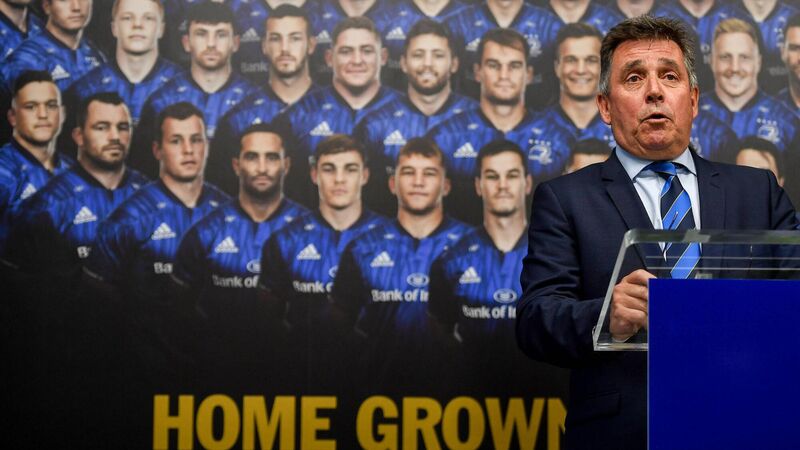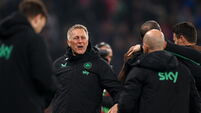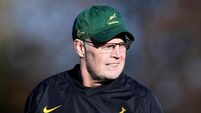Tommy Martin: Why the FAI should pick up the phone to Mick Dawson

Former Leinster CEO Mick Dawson transformed rugby in the province over the past 20 years. Could his expertise be utilised to do likewise for Irish football?
The Sunday papers last weekend carried spreads with the CEO of Leinster Rugby, Mick Dawson, who is stepping down after 21 years in the job.
His is the classic tale of humble stockbroker folk. Dawson got the top gig at Leinster despite only having two decades at Davy’s to his name. Fair to say he made a go of it. Leinster’s turnover is now 13 times what it was when he took over, while a skeleton crew of 30 players has been transformed into a staff of 200, divided between first team, academy, player development and administration.
Oh, and there’s been four Heineken Cups and the move to the RDS as well.
Dawson comes across as a decent skin – bold enough to envision the glossy Leinster operation of today from ramshackle beginnings, humble enough to learn from his mistakes. But what really wafts from the story of Leinster’s success is the sweet perfume of money. Not only have Dawson and crew been expert at generating their own income, but they have also been adept at the corporate shakedown.
Business friends and associates of Dawson’s include David Shubotham, another former stockbroker who donated €2.2 million for the Leinster HQ building in UCD. Other well-to-do pals stumped up €500,000 for the recently completed centre of excellence in Donnybrook. According to the Sunday Independent, the club are also hoping to buy a seven-bedroom house in Goatstown for their academy – which, by today’s property prices, won’t come cheap.
As well as hard cash donations, there is that lovely pillow of soft money that surrounds Leinster rugby. Private schools like St Michael’s and Blackrock operate what amount to mini-academies, well-funded hothouses for teenage talent who emerge ready to step into the professional game. To their credit, Dawson says Leinster want to divide the province into five areas with centres of excellence in each, but there is no doubt they have benefited from their prime location among Ireland’s wealthiest postcodes.
None of which is to take away from what has been built at Leinster. They have made the most of their advantages. Don’t hate me because I’m beautiful, and all that. Still, with all this talk of academies, facilities and bountiful investment, the mind wanders to that less well-funded corner of our sporting landscape: Irish soccer.
In microcosm, take the example of Tolka Park. Owned by Dublin City Council, the current plan for the ground is to sell it off to property developers to help fund the redevelopment of Dalymount Park, which is also municipal property. This plan prompted the formation of the Save Tolka Park campaign, which is battling to preserve a historic ground and maintain it for use by the wider community.
The council’s logic for selling the ground was philosophical as well as financial. It was deemed unnecessary to have two small football stadiums within 2.5km of each other on Dublin’s northside, especially when the cost of doing them up would be borne by the public purse. There are, of course, two rugby stadiums within 850m of each other on Dublin’s southside. The renovated Energia Park (formerly Donnybrook stadium) plays host to schools, club and underage international matches, while a stone’s throw away is the home of Leinster and the Irish women’s team at the RDS.
Therefore, without stating the obvious, the difference between the soccer community on Dublin’s northside and their rugby equivalents in the south of the city is access to money, whether from sponsors, private investors or simply the spending power of supporters.
Draw the camera back from the Tolka Park issue and you see the problems of Irish soccer writ large. The game is crying out for investment in the post-Delaney, post-Brexit era. It needs to renovate stadiums, to build and run youth academies, as well as improve standards in the League of Ireland, which would in turn help European performances and bring a virtuous circle of financial rewards.
The government (as well as UEFA) was the investor of last resort in the aftermath of the FAI’s financial meltdown and, still awaiting a title sponsor for the men’s international team, the corporate world is yet to fully reengage. Taoiseach Micheal Martin has said that the state would continue “stepping up to the plate” when it comes to investment in soccer. It is only right that it does. To say so might get you classed as a dangerous, looney lefty in modern, neo-liberal Ireland, but it can’t be right that an accident of birth dictates whether you have access to decent sporting facilities.
Of course, the FAI needs to get its house in order and it’s probably encouraging that its independent chairman, Roy Barrett, is also a former stockbroker type. Tolka Park’s future looks a little brighter too, after it was announced in February that Shelbourne FC had made an offer to Dublin City Council to buy back the stadium. If the bid is successful, the club (subsequently reported by the Sunday Times to be the subject of a planned seven-figure investment by a consortium of financiers) would redevelop the ground as a multi-sport stadium.
Private money is starting to trickle into the League of Ireland in greater quantities: as well as the mooted Shelbourne investors, Derry City’s chairman Philip O’Doherty sold his engineering business for €2 billion last year and is investing heavily in the club; Galway United members recently approved a takeover by the Comer brothers, billionaire property developers and long-term club sponsors. But the experience of Dundalk, whose takeover by the US investment firm Peak6 was a disaster, suggests the invisible hand of the free market doesn’t always guide you in the right direction.
Irish football does not enjoy the moneyed milieu of Leinster rugby, hence why the redistributive powers of the state must help level that playing field. But it still needs to do many of the same things that Leinster did so well over the last two decades: build youth academies, prioritise player development, expand commercially and project an overall image of basic competence. Funnily enough, I hear that Dawson guy is at a loose end these days…









